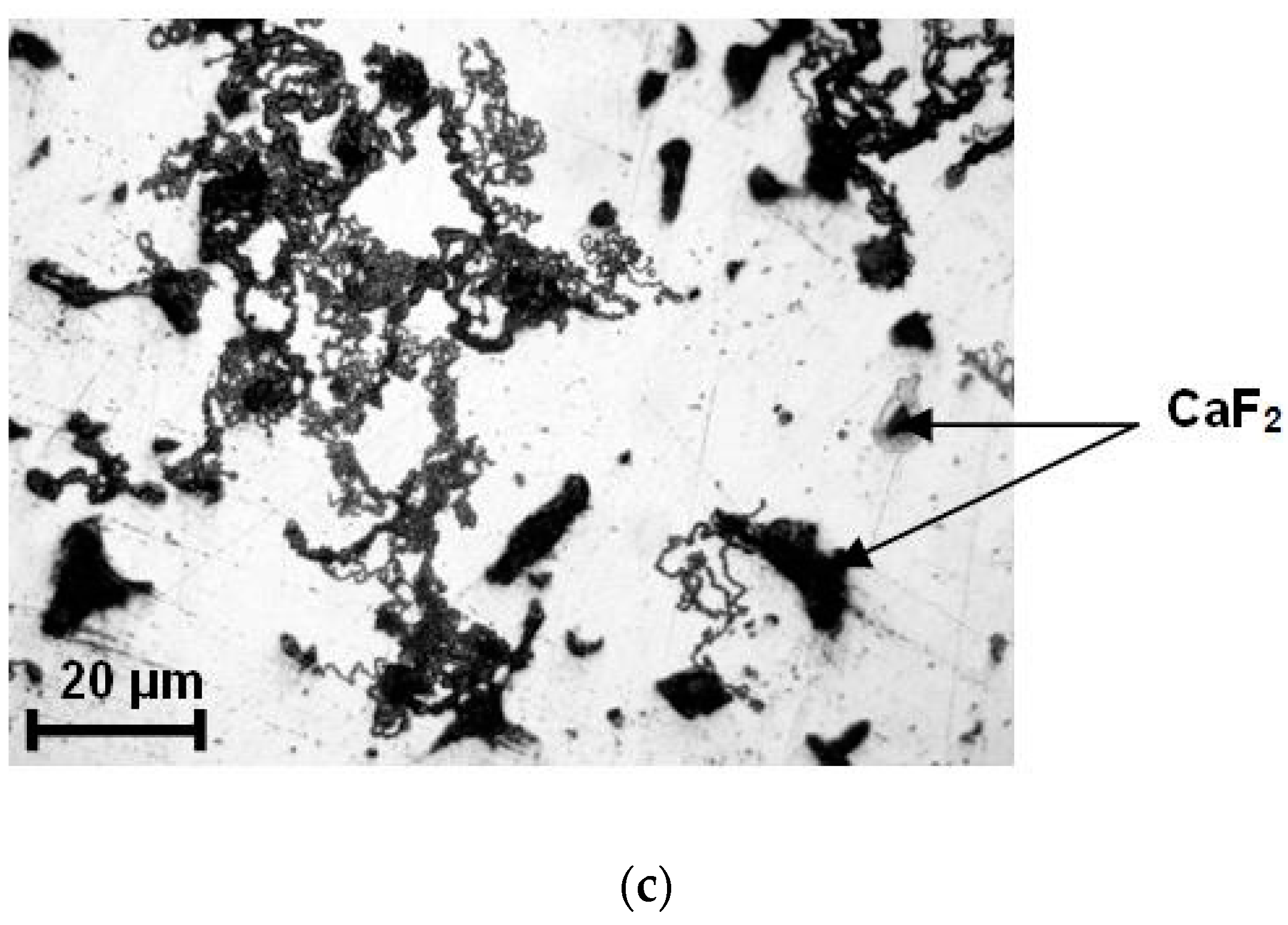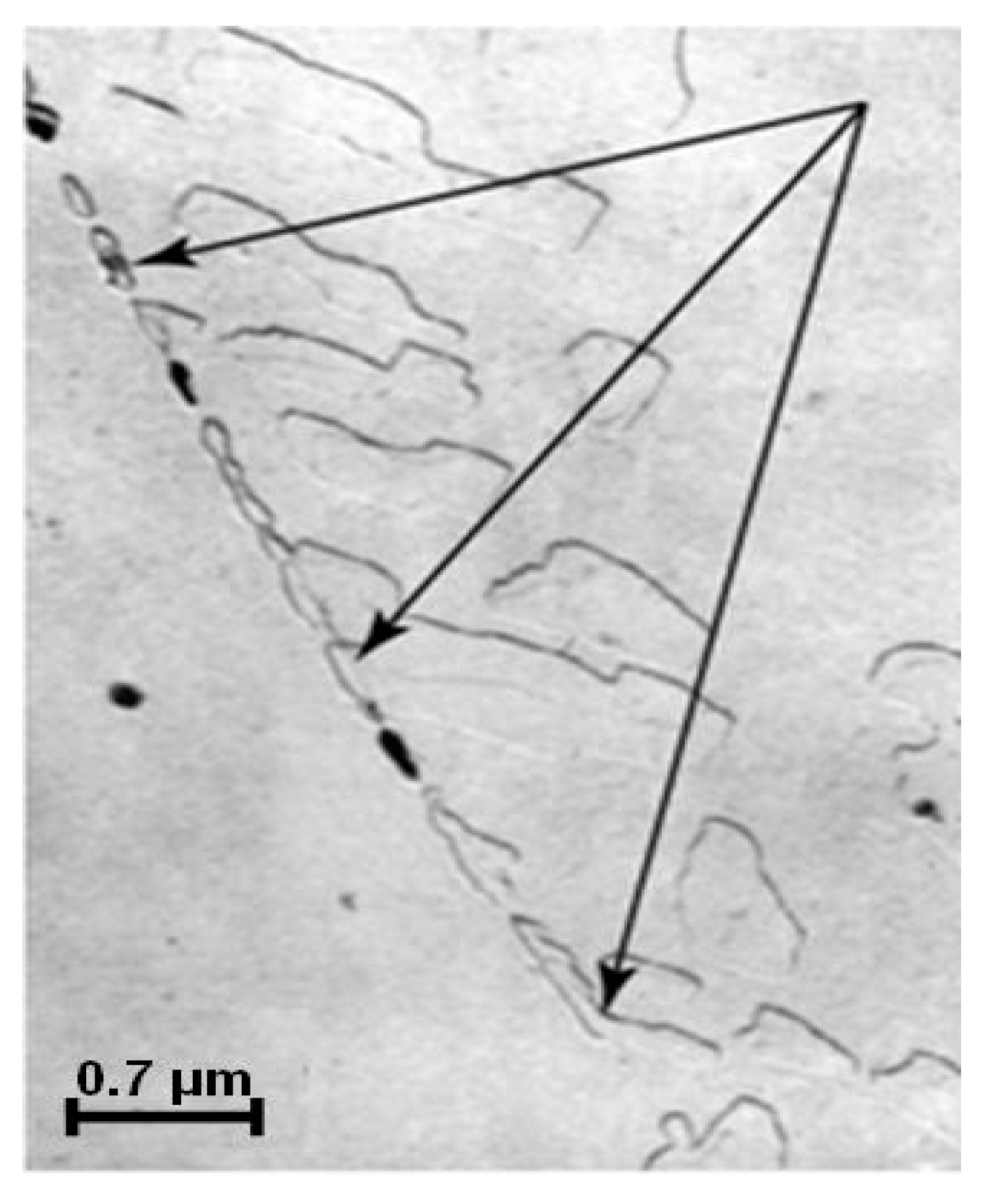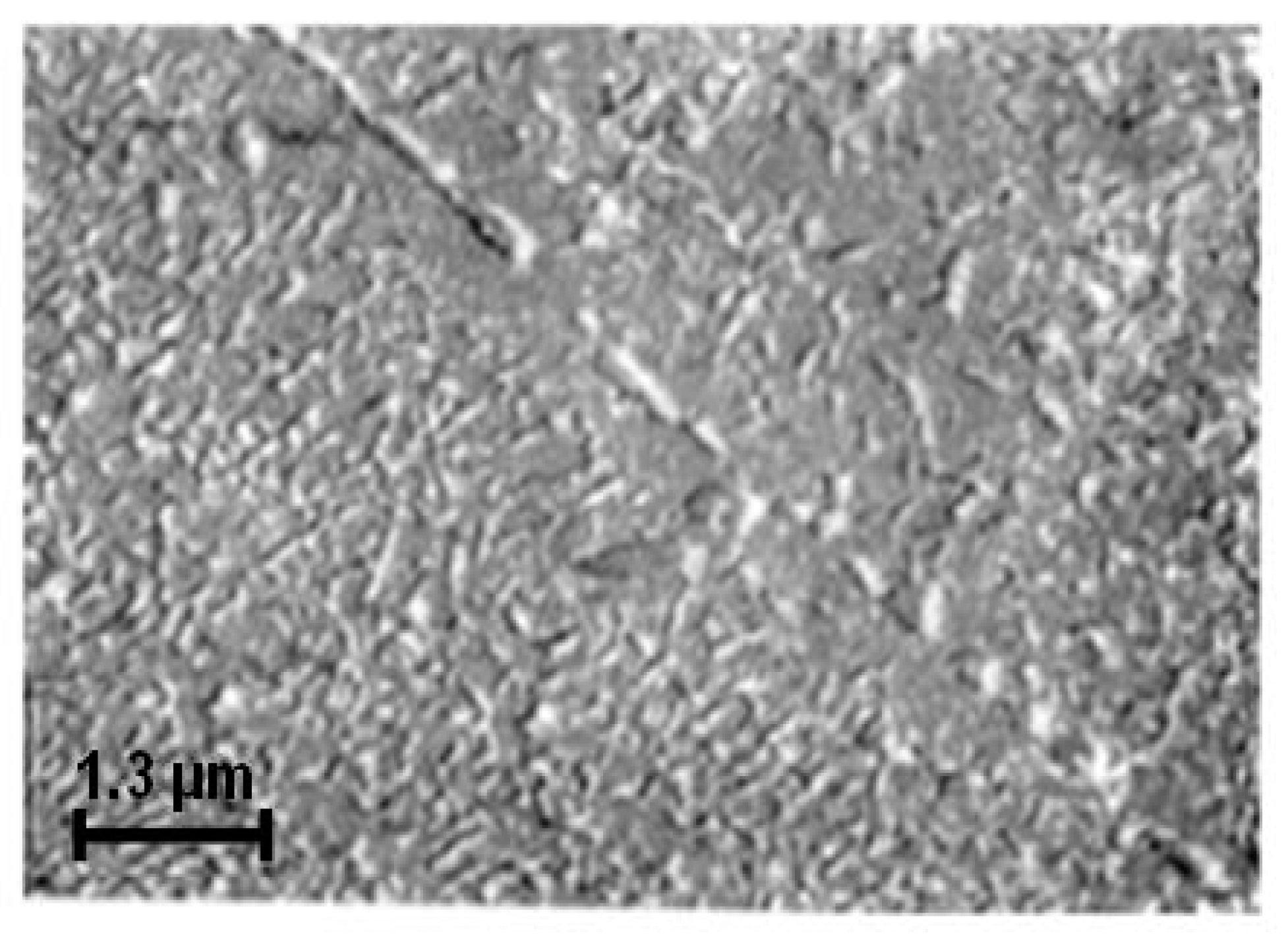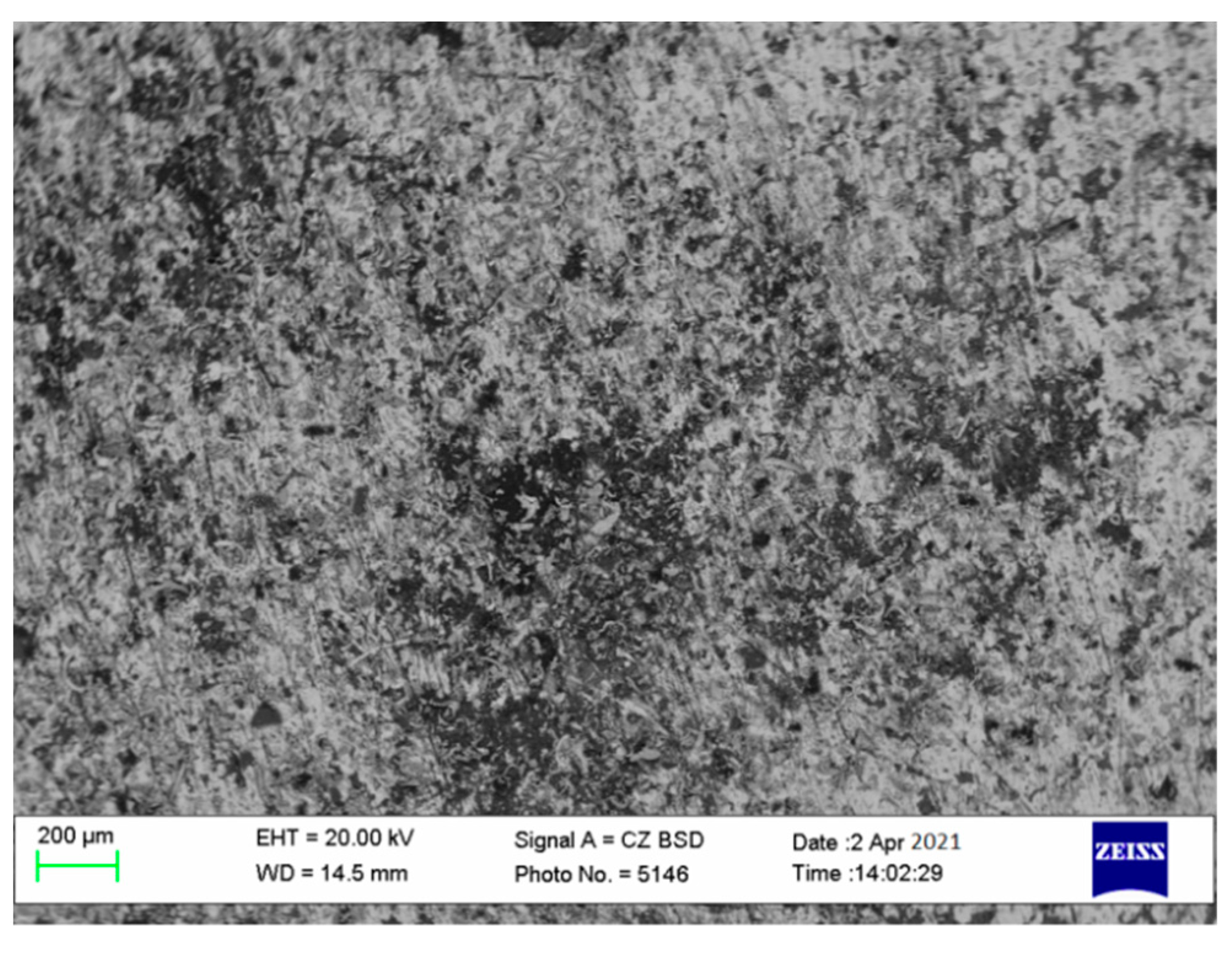New Antifriction Composites for Printing Machines Based on Tool Steel Grinding Waste
Abstract
:1. Introduction
2. Experimental Procedure
2.1. Preparatory Procedures
2.2. Charge Preparation and Consolidation
2.3. Examination Techniques
3. Experimental Results and Discussion
- -
- Me23C6 type—(Cr, Fe, Mo, W, V)23C6 is a complex chromium carbide; it has a size of 3–5 microns and retains a high dispersion due to a low coagulation tendency;
- -
- Me7C3 type—(Cr, Fe, Mo, W, V)7C3 is complex chromium carbide in which V, W, and Mo are dissolved; it increases the resistance of 4H4VMFS steel against softening during heating. This carbide was found to significantly increase wear resistance [22,23,26], which also contributes to an increase in antifriction properties during operation under severe friction conditions.
- -
- Me6C type—(Mo, Fe, Cr, W, V)6C is complex carbide with high hardness that increases wear resistance and decreases the friction coefficient value;
- -
- Me2C and MeC types are Mo and W carbides (Mo2C, W2C), as well as VC carbides. These carbides contribute to increased hardness.
4. Conclusions
Author Contributions
Funding
Institutional Review Board Statement
Informed Consent Statement
Data Availability Statement
Conflicts of Interest
References
- Childs, P.R.N. Journal bearings. In Mechanical Design Engineering Handbook, 2nd ed.; Elsevier Ltd.: Oxford, UK, 2019; Chapter 5; pp. 167–230. [Google Scholar] [CrossRef]
- Childs, P.R.N. Rolling element bearings. In Mechanical Design Engineering Handbook, 2nd ed.; Elsevier Ltd.: Oxford, UK, 2019; Chapter 6; pp. 231–295. [Google Scholar] [CrossRef]
- Samal, P.K.; Newkirk, J.W. (Eds.) Powder Metallurgy: The Materials International Society; ASM Handbook: New York, NY, USA, 2015; Volume 7, ISBN 978-1-62708-089-3. [Google Scholar]
- Maguire, D.E.; Phelps, N.; Simmons, C.H. Bearings and Applied Technology. In Manual of Engineering Drawing, 4th ed.; Elsevier Ltd.: Oxford, UK, 2012; Chapter 35; pp. 315–330. [Google Scholar] [CrossRef]
- Neale, M.J. (Ed.) The Tribology Handbook, 2nd ed.; Elsevier Ltd.: Oxford, UK, 1996; ISBN 978-0-7506-1198-5. [Google Scholar] [CrossRef]
- Roik, T.A.; Gavrish, O.A.; Vitsiuk, I. The phase composition and structure of the antifriction copper-based composite and their influence on tribological properties. Powder Metall. Met. Ceram. 2021, 60, 191–197. [Google Scholar] [CrossRef]
- Jamroziak, K.; Roik, T.; Gavrish, O.; Vitsiuk, I.; Lesiuk, G.; Correia, J.A.; De Jesus, A. Improved manufacturing performance of a new antifriction composite parts based on copper. Eng. Fail. Anal. 2018, 91, 225–233. [Google Scholar] [CrossRef]
- Roik, T.A.; Gavrish, A.P.; Kirichok, P.A.; Vitsyuk, Y. Effect of secondary structures on the functional properties of high-speed sintered bearings for printing machines. Powder Metall. Met. Ceram. 2015, 54, 119–127. [Google Scholar] [CrossRef]
- Mohan, S.; Anand, A.; Singh, R.A.; Jayalakshmi, S.; Chen, X.; Konovalov, S. Friction and Wear Study of Fe-Cu-C-CaF2 Self-lubricating Composite at High Speed and High Temperature. In Proceedings of the 6th International Conference on Advances in Mechanical Engineering 2019 (ICAME 2019), Kota Kinabalu, Malaysia, 14−16 August 2019; Volume 834. [Google Scholar]
- Chen, Z.; Guo, N.; Ji, L.; Xu, C. Synthesis of CaF2 nanoparticles coated by SiO2 for improved Al2O3/TiC self-lubricating ceramic composites. Nanomaterials 2019, 9, 1522. [Google Scholar] [CrossRef] [PubMed] [Green Version]
- Kotkowiak, M.; Piasecki, A.; Kulka, M. The influence of solid lubricant on tribological properties of sintered Ni–20%CaF2 composite material. Ceram. Int. 2019, 45, 17103–17113. [Google Scholar] [CrossRef]
- Zhang, Y.; Chromik, R.R. Tribology of Self-Lubricating Metal Matrix Composites. In Self-Lubricating Composites; Springer Nature: Berlin/Heidelberg, Germany, 2018; pp. 33–73. ISBN 978-3-662-56528-5. [Google Scholar]
- Zhen, J.; Li, F.; Zhu, S.; Ma, J.; Qiao, Z.; Liu, W.; Yang, J. Friction and wear behavior of nickel-alloy-based high temperature self-lubricating composites against Si3N4 and Inconel 718. Tribol. Int. 2014, 75, 1–9. [Google Scholar] [CrossRef]
- Wu, G.; Xu, C.; Xiao, G.; Yi, M. Recent Progress in Self-Lubricating Ceramic Composites. In Self-Lubricating Composites; Springer Nature: Berlin/Heidelberg, Germany, 2018; pp. 133–154. ISBN 978-3-662-56528-5. [Google Scholar]
- Kurzawa, A.; Roik, T.; Gavrysh, O.; Vitsiuk, I.; Bocian, M.; Pyka, D.; Zajac, P.; Jamroziak, K. Friction mechanism features of the nickel-based composite antifriction materials at high temperatures. Coatings 2020, 10, 454. [Google Scholar] [CrossRef]
- Höganäs AB Laboratory. Material and Powder Properties; Höganäs Handbook for Sintered Components; Höganäs AB Laboratory: Höganäs, Sweden, 2013; 113p. [Google Scholar]
- Kruzhanov, V. Modern Manufacturing of Powder-Metallurgical Products with High Density and Performance by Press–Sinter Technology. Powder Metall. Met. Ceram. 2018, 57, 431–446. [Google Scholar] [CrossRef]
- Oro, R.; Campos, M.; Gierl-Mayer, C.; Danninger, H.; Torralba, J.M. New Alloying Systems for Sintered Steels: Critical Aspects of Sintering Behavior. Metall. Mater. Trans. A 2015, 46, 1349–1359. [Google Scholar] [CrossRef] [Green Version]
- Roik, T.; Rashedi, A.M.; Khanam, T.; Chaubey, A.; Balaganesan, G.; Ali, S. Structure and properties of new antifriction composites based on tool steel grinding waste. Sustainability 2021, 13, 8823. [Google Scholar] [CrossRef]
- Jamroziak, K.; Roik, T. New Antifriction Composite Materials Based On Tool Steel Grinding Waste. WIT Trans. Eng. Sci. 2019, 124, pp. 151–159. [Google Scholar] [CrossRef] [Green Version]
- Roik, T.A.; Gavrysh, O.A.; Vitsiuk, I. Tribotechnical Properties of Composite Materials Produced from ShKh15SG Steel Grinding Waste. Powder Metall. Met. Ceram. 2019, 58, 439–445. [Google Scholar] [CrossRef]
- Højerslev, C. Tool Steels; Risø National Laboratory: Roskilde, Denmark, 2001. [Google Scholar]
- Ghali, S.; Eissa, M.; Mishreky, M. Some Features of the Influence of Titanium and Nitrogen Addition to NiCrMoV Steel. J. Miner. Mater. Charact. Eng. 2018, 6, 203–217. [Google Scholar] [CrossRef] [Green Version]
- Danninger, H.; Rouzbahani, F.; Ponemayr, H. Powder Metallurgy Carbon Free Tool Steels Fe-Co-Mo With Varying Co And Mo Contents. Mater. Sci. 2013, 13, 47. [Google Scholar]
- Nurbanasari, M.; Tsakiropoulos, P.; Palmiere, E. Microstructural Evolution of a Heat-Treated H23 Tool Steel. Int. J. Miner. Metall. Mater. 2015, 22, 272–284. [Google Scholar] [CrossRef]
- Eric, O.; Jones, F.D.; McCauley, C.J.; Hill Ricardo, M. Machinery’s Handbook, 27th ed.; Industrial Press Inc.: New York, NY, USA, 2004; 2704p, ISBN 978-0-8311-2700-8. [Google Scholar]
- John, V. Steel Metallurgy for the Non-Metallurgist; ASM International: Almere, The Netherlands, 2007; 159p, ISBN 978-0-87170-858-8. [Google Scholar]
- Muhammadi, I.U.; Hadi, R.; Nadeem, S.G.; Khan, N.; Ibrahim, F.; Hassan, M.Z.; Khanam, T.; Jeong, B.; Hussain, M. Characterization and Life Cycle Exergo-Environmental Analysis of Wood Pellet Biofuel Produced in Khyber Pakhtunkhwa, Pakistan. Sustainability 2022, 14, 2082. [Google Scholar] [CrossRef]
- Raza, A.; Rashedi, A.; Rafique, U.; Hossain, N.; Akinyemi, B.; Naveen, J. On the Structural Performance of Recycled Aggregate Concrete Columns with Glass Fiber-Reinforced Composite Bars and Hoops. Polymers 2021, 13, 1508. [Google Scholar] [CrossRef] [PubMed]
- Khanam, T.; Jonkman, M. On Reduced Consumption of Fossil Fuels in 2020 and Its Consequences in Global Environment and Exergy Demand. Energies 2020, 13, 6048. [Google Scholar] [CrossRef]
- Sridhar, I.; Tseng, K. Life cycle assessment of 50 MW wind firms and strategies for impact reduction. Renew. Sustain. Energy Rev. 2012, 21, 89–101. [Google Scholar]






| Components, wt.% | ||||||||||
|---|---|---|---|---|---|---|---|---|---|---|
| C | W | Cr | Mo | Si | Mn | V | S | P | Fe | CaF2 |
| 0.37–0.44 | 0.8–1.2 | 3.2–4.0 | 1.2–1.5 | 0.60–1.0 | 0.2–0.5 | 0.6–0.9 | 0.02–0.03 | 0.02–0.03 | basis | 4.0–6.0 |
| Composition, wt.% | Bending Strength, σs, MPa | Hardness, HB, MPa | Friction Coefficient, V = 7000 rpm | Wear Rate, µm/km, V = 7000 rpm | Wear Rate, µm/km, V = 8000 rpm |
|---|---|---|---|---|---|
| 4H4VMFS + 5CaF2 | 320−360 | 800−820 | 0.18−0.22 | 64−67 | 340−420 |
| Bronze cast alloy C83600 * (Cu85Sn5Zn5Pb5), C93200 Standard ASTM, USA | 147−240 | 380−400 | 0.30−0.42 | 490−520 | 980−1036 |
Publisher’s Note: MDPI stays neutral with regard to jurisdictional claims in published maps and institutional affiliations. |
© 2022 by the authors. Licensee MDPI, Basel, Switzerland. This article is an open access article distributed under the terms and conditions of the Creative Commons Attribution (CC BY) license (https://creativecommons.org/licenses/by/4.0/).
Share and Cite
Roik, T.; Gavrysh, O.; Rashedi, A.; Khanam, T.; Raza, A.; Jeong, B. New Antifriction Composites for Printing Machines Based on Tool Steel Grinding Waste. Sustainability 2022, 14, 2799. https://doi.org/10.3390/su14052799
Roik T, Gavrysh O, Rashedi A, Khanam T, Raza A, Jeong B. New Antifriction Composites for Printing Machines Based on Tool Steel Grinding Waste. Sustainability. 2022; 14(5):2799. https://doi.org/10.3390/su14052799
Chicago/Turabian StyleRoik, Tetiana, Oleg Gavrysh, Ahmad Rashedi, Taslima Khanam, Ali Raza, and Byongug Jeong. 2022. "New Antifriction Composites for Printing Machines Based on Tool Steel Grinding Waste" Sustainability 14, no. 5: 2799. https://doi.org/10.3390/su14052799
APA StyleRoik, T., Gavrysh, O., Rashedi, A., Khanam, T., Raza, A., & Jeong, B. (2022). New Antifriction Composites for Printing Machines Based on Tool Steel Grinding Waste. Sustainability, 14(5), 2799. https://doi.org/10.3390/su14052799







